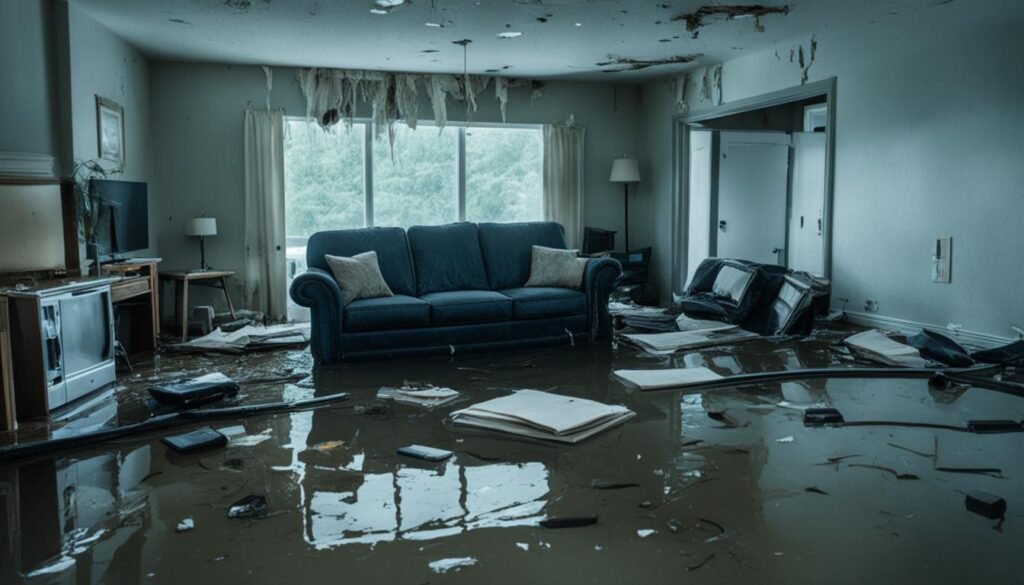Did you know that home floods affect millions of households each year in the United States alone?
Floods can wreck your home in no time. It is critical to act fast after a flood to avoid long-term damage. Starting the cleanup within the first 24 hours is key to reducing harm.
This guide will show you how urgent and important it is to begin flood cleanup quickly. Learn the steps and techniques that can help get your home back to how it was before.
Key Takeaways:
- Home floods are a common occurrence, impacting millions of households every year in the United States.
- Immediate action within the first 24 hours is crucial to minimize the destructive consequences of water damage.
- Swift home flood restoration prevents structural issues, mold growth, and irreversible harm to valuable possessions.
- This guide will provide comprehensive steps and techniques for efficient home flood restoration.
- Restoring your home after a flood requires prompt action and effective strategies.
Essential Equipment for Home Flood Restoration
Starting your home flood restoration requires the right tools. Having the necessary equipment helps you reduce damage and speed up your home’s recovery. Below are important tools to help in the flood cleanup process:
| Equipment | Function |
|---|---|
| Water extraction devices | Effectively remove standing water from your home. |
| Moisture meters | Determine the moisture content in different materials, guiding the restoration process. |
| Dehumidifiers | Reduce and control humidity levels, preventing mold growth and aiding in drying. |
| Air movers | Improve airflow and accelerate evaporation, expediting the drying process. |
For these tools, you can either rent or buy them. First, check local hardware stores or home improvement centers for rentals. Renting is cost-effective for one-time use in flood cleanup. Or buy them if you think you’ll need the tools again. Look for good deals, read reviews, and pick trustworthy suppliers for quality equipment.
Safety is key during flood restoration. Wear gloves, masks, and boots to protect against hazards. Now you know the tools and safety tips, let’s check out the flood cleanup checklist for a thorough and organized process.
Understanding Water Damage Categories and Restoration Techniques
Home flood restoration requires knowing the water damage types and restoration methods. Knowing your situation’s severity lets you act quickly. This will limit more damage. Let’s look at these categories and their restoration methods:
Clean Water Damage
Category 1 is clean water damage, like from broken pipes or rainwater. If clean water damages your home, you can often fix it yourself. You’d use DIY flood cleanup techniques.
Here are some DIY flood cleanup techniques for handling clean water damage:
- Shutting off the water source, if possible
- Removing standing water using a wet/dry vacuum or mop
- Drying affected areas with fans and dehumidifiers
- Sanitizing and disinfecting surfaces to prevent mold growth
Grey Water Damage
Category 2, or grey water, has harmful microbes and can make you sick. It comes from appliances, toilet overflows, or washing machine discharge.
For grey water damage, it’s wise to call professional flood cleanup services. They’re equipped to handle the damage safely, including:
- Extracting standing water with specialized equipment
- Thoroughly cleaning and disinfecting affected areas
- Applying antimicrobial treatments to prevent further contamination
Black Water Damage
Category 3, known as black water, is severe and dangerous. It’s from sewage, flooded rivers, or streams. It carries harmful bacteria and substances.
Black water damage needs immediate professional help. Professional flood cleanup services are prepared for safe, effective restoration, such as:
- Assessing the damage and planning restoration
- Extracting water with commercial-grade pumps
- Removing unsalvageable materials safely
- Drying, dehumidifying, and disinfecting to prevent contamination
“Acting fast on water damage prevents long-term issues. Swift and professional action ensures safe, thorough restoration.”
While you might manage minor clean water damage yourself, grey or black water damage requires professional flood cleanup services. They have the right tools and knowledge for a safe, effective home restoration.

Tips for a Successful Home Flood Cleanup and Conclusion
When a flood hits your home, cleanup can seem overwhelming. However, by following the right steps, you can make the process smoother. Here are essential tips for a successful flood cleanup:
- First, make sure you’re safe. Shut off any electrical sources. Leave if you need to, until it’s safe to come back.
- Wear protective gear like gloves, boots, and masks. This keeps you safe from harmful stuff during cleanup.
- Start removing standing water with pumps, wet vacuums, or buckets. Be sure to dump the water correctly to avoid more problems.
- Dry areas well with dehumidifiers and fans. This stops mold from growing and keeps damage low.
- Clean the area with the right solutions to kill any bad germs or dirt.
- Check your things and see how much damage there is. Clean and dry things that can be saved.
- Get rid of stuff like carpets and drywall that can’t be saved. It prevents mold and further damage.
- If the cleanup feels too big, or you’re not sure what to do, think about hiring professionals.
With these tips and by being careful, you can fix your flood-hit home. It won’t be easy, but it’s doable.


